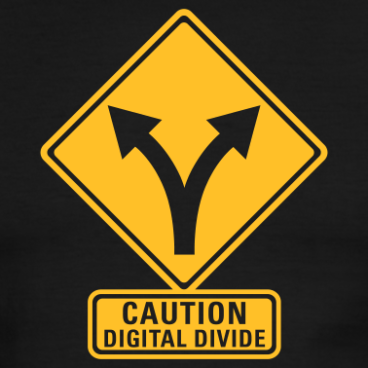The digital divide refers to the difference/gap between people who have access to computers and the internet to those who do not. This can usually be divided by race, income, gender and educational attainment. Many of us may not realize it in this day and age but there are many individuals who still can not afford home internet access. Depending on the areas, they may not be able to obtain access at the schools either, which leaves them behind their peers and the rest of the world. As the middle class shrinks and the economy struggles the divide will continue to grow if something is not done about it soon.
According to an article on Mashable.com by Jessica Goodman she stated that “In June, a White House broadband report concluded the divide is still very much present in the U.S. Though the report found that 91% of Americans had access to high-speed Internet service of at least 10 Mbps downstream, only 71% of Americans actually subscribed to broadband at home — an adoption rate lower than other nations with a similar GDP.” This shows that if the economy still continues to struggle that the divide might grow even more. It is because the group that is most without technology is Hispanics and African Americans, and these are the same groups that will make up a majority of the population and workforce in the coming years. It is important to take into consideration however that many individuals opt out of home internet access because they use their smartphone as their primary source to access the internet. With this though many individuals also have a lack of simple computer skills and they can’t complete the same type of work on smart phones as they would on computers.
As stated in the paper written by Robyn Broadbent and Theo Papadopoulos titled “Bridging the digital divide-an Australian story” “There is increasing evidence that the lack of access to information and communication technology (ICT) or the ‘digital divide’ severely limits education, employment and economic prospects.” The digital divide harms students on an incredibly large scale as almost everything nowadays is done on the computer and with the help of the internet. I personally wish I could use the computer less but there is no way around it because all my school work, all the research for papers and many times the method to turn in assignments requires the use of the internet. When it comes to lower income communities there really aren’t other alternatives unless outside sources help them out. For instance, non profits like Close the Gap who “is an international non-profit organisation that aims to bridge the digital divide by offering high-quality, pre-owned computers donated by large and medium-sized corporations or public organisations to educational, medical, entrepreneurial and social projects in developing and emerging countries.” If children fall behind at an early age and don’t gain the proper skills we will be creating a future workforce who will not be able to compete at a high level.
I believe that there should at least be an attempt to lower the cost of internet as it is something everyone requires and that they suffer without it. With corporations though all they usually see is profit so it is a long stretch to see that happen without any government interference and that would bring in the question of “isn’t this a free market?” As I see it, it would be very beneficial for local libraries to be set up if not already there and then for them to have wi-fi which most if not all already do. This is how I got by when I did not have internet at home. There are many different issues at play here from minimum wages, to technological advances, neighborhood atmospheres and many more. How I see it though having a community center such as a library would be very beneficial and groups like Close the Gap who do so much to help out are the best options. Sadly I don’t ever see everyone being equal but they should have equal opportunities to basic needs and the internet has become one.

